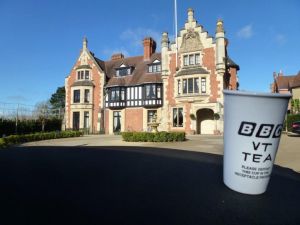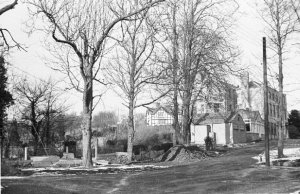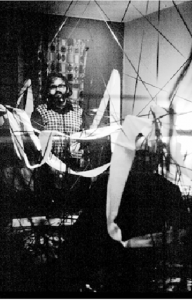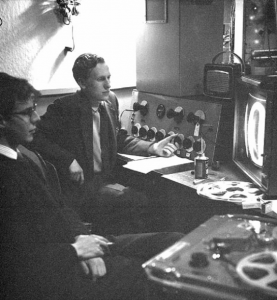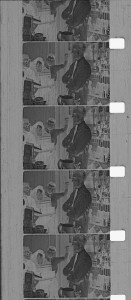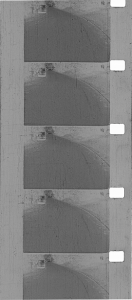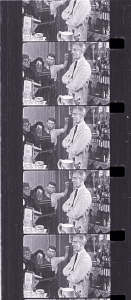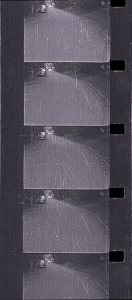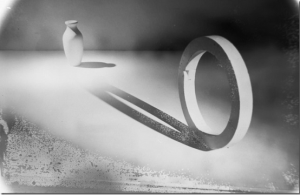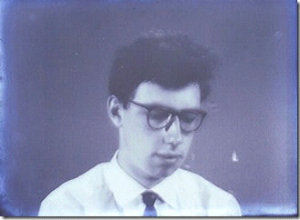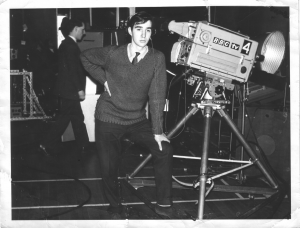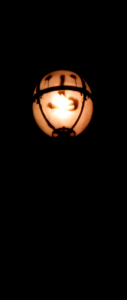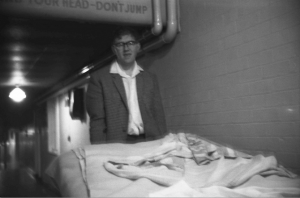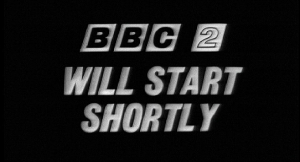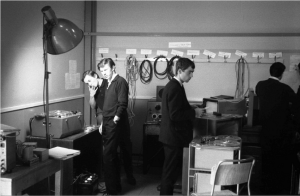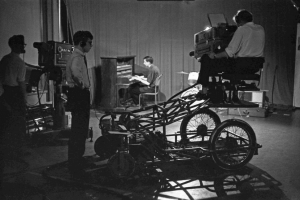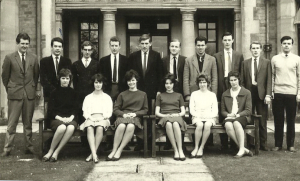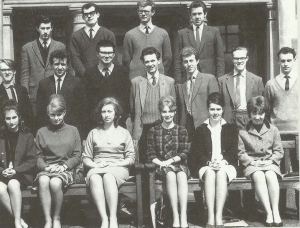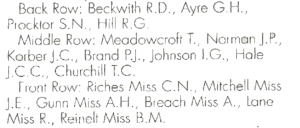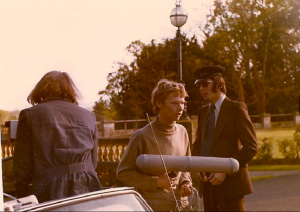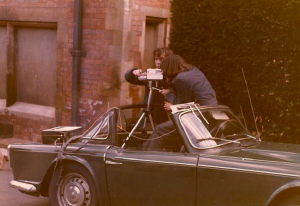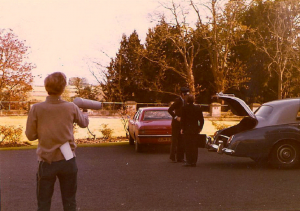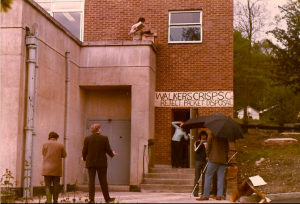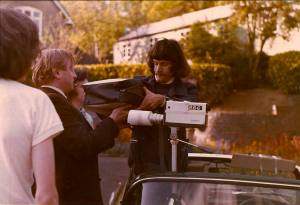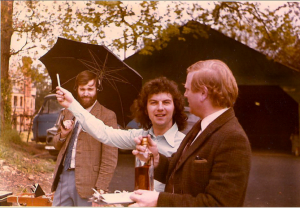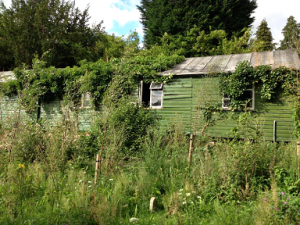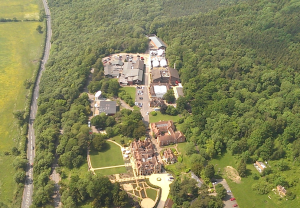Background
Wood Norton Hall near Evesham is a Grade II listed Victorian stately home near Evesham, Worcestershire, England. It was the last home in England of Prince Philippe, Duke of Orléans, who claimed the throne of France.
It was used by the British Broadcasting Corporation during World War II as a station for listening to enemy radio broadcasts and an emergency broadcasting centre. A dozen studios were built, and by 1940 Wood Norton was one of the largest broadcasting centres in Europe with an average output of 1,300 programmes a week.
After the war, Wood Norton became the home of the BBC Engineering Training Department. During the Cold War it was designated as a broadcasting centre in the event of a nuclear attack. The BBC retained purpose-built facilities in the grounds for technical training after selling the Hall, which became a hotel.
[Wikipedia]
Patrick Heigham
Having been subjected to A-Levels in Physics and Chemistry at both school and Technical College, I was intrigued that at Wood Norton, we were taken through what was effectively the “A” Level syllabus in Physics (but concentrating on Light, Magnetism, Sound, Electricity) all over again. Brilliant training, and sadly lacking now.
Those of us lucky enough, knew what we were doing, but more importantly, why!
Alec Bray
I joined BBC TV Tech Ops straight from school, where I had attempted “A” Levels in Latin, French and German (didn’t get Latin …) so the A-Level syllabus in Physics at Wood Norton was all good new stuff to me!
Training 1956
Doug Coldwell
Hampton House was another WW2 type dormitory, housing about 40, opened to relieve the Wood Norton overcrowding. A BBC bus shuttled us to and from each day and we were left very much to our own devices. Brilliant.
Michael Cotton
1956 New entry Course of Hampton
I came back from a 48 hour pass (on an STO Course, sorry, weekend at home) to find my room tastefully redecorated.
Colin Dixon was driving from Hampton to Wood Norton for Sunday lunch when he was overtaken by a car wheel bowling along – it turned out to be his having failed to tighten the nuts after maintenance. He quickly dived into the nearest pub and recruited several burly men to lift the car up whilst he reunited the car with its wheel and then carried on his merry way to sample what WN had to offer.
JPTO course No. 1
Clive Doig
The JPTO course No.1 was at Evesham in 1959, although we joined in 1958. We were the first Juniors (“J” for Junior) Probationary Technical Operators and Assistants to be employed straight from school at 18 and 19, as we all luckily missed National Service by a few months. Cliff White in Bristol arranged a re-union for the 50th anniversary of us joining the BBC back in 2008. The BBC TV and Radio, Ariel, Prospero, Radio Times couldn’t have given a stuff! Nobody was interested in the first group of teenage techies all those years ago getting together and what had become of us all, and there was no mention anywhere, not even on local radio.
PTO course No. 3
Hugh Sheppard
I don’t remember a “J” for the November 1958 to January/February 1959, (possibly no 3), the one graced by Geoff Feld, Julian Tolkein, Bob Booth, Mike Pontin, John Hays (I think) and 20-odd others;
It was the treatment of those who ‘failed’ like Bob Booth, who was sent on his way, that got to me. No-one knew how the pass or fail awards were handed out and Bob’s prob. was that he was cheeky; an end of course sketch item about ‘Dr. Sturley gets up early…’ did not endear him to the then Head of Engineering Training. Mike Pontin (anyone still in touch?) had a Scott Squirrel motor-bike when we were subsequently banished to AP and something smaller at Evesham. One awful winter’s day returning to Wood Norton, he was late back because of a puncture. Not only was he admonished, but Duncan McKewan, then No. 2 to Sturley, insisted on accompanying him to the bike shed to see if the tyre was worn and he should have anticipated the problem.
I was one half of a team that produced a spoof memo at Evesham. …
As we neared the end of incarceration on the PTO Course in 1959 – postings hither and thither and departures were announced by Wood Norton management. The subject of the spoof had high hopes of his high marks gaining recognition, and two of us ensured that’s what happened. Courtesy of BBC headed notepaper, an envelope and a typewriter, we sent him a congratulatory memo, appointing him to a course in Sound Mixing (Music) at Aeolian Hall, signed by a suitable Head of Department who we identified as ‘B. K. Dennison’. (To this day, I cannot credit there has never been a B. K. Dennison, a name that precisely smacks of the BBC).
The memo showed it was copied to Dr. Sturley (untrue), then the Evesham supremo, who we hadn’t bargained on arriving in the classroom first thing to fire off some impromptu questions. He pressed our friend to respond about cameras, from which he escaped by drawing out the memo and presenting it to Sturley. After a pause, Sturley fell for it, then heartily shook his hand and praised him in front of the whole course. Since most of our colleagues were in the dark about this, they joined in the congratulations, save for two of us who were indubitably bright puce!
Sturley soon went on his way, but flounced back in ten-minutes later, demanded the memo and disappeared again. Harry Henderson (praise be) was the then instructor, and my partner in crime, a braver man than me, took him aside and quietly spilled the beans. To our anguish, Harry then carried on teaching, but after 10 minutes he too disappeared for what seemed an age. When he came back, he returned the memo without a word, and carried on teaching. Only much later did we learn he had caught Sturley on the phone to London and tearing into an operator who could not trace anyone called Dennison. Somehow, Henderson persuaded Sturley that it might be best if none of this got out, in case he might become the laughing stock.
Oh, my paws and whiskers, that was a close one! If apologies still seem overdue, let me sincerely offer them now. Fortunately, no one’s career suffered – unusual for Wood Norton misdemeanours.
Alex Thomas
I was sent to Wood Norton in March 1960 to join PTO 7.
Hugh Sheppard
So if Alex was on PTO course no. 7 from March 1960, how many did they run? I was on a PTO course in the severe winter of 1958 – 9 (PTO 2 or 3), which would work out alright if there were 4 a year.
Failing the end of course exam was a meaningful threat. A lovely, witty man called Bob Booth went out on his ear from our course for being too cheeky… I’ve always thought my being sent to AP was just one step above the same fate. What ‘they’ hadn’t bargained on was that learning on a Pye pesticon pointing at Bob Dougall gave a grounding that helped let us loose sooner on ‘real’ cameras at Lime Grove.
TO ?
Pat Heigham
I remember my TO course – we had to produce a programme, viewed by the tutors in another hut.
We discovered a telecine machine covered in dust, and thought we should have a TC insert – I remember John Henshall looking after the machine.
At the time, a branch railway line was about to be closed, so a couple of chaps (John Sandiford from Bristol, I remember) took a mains powered tape recorder in a car or van, and ran a mic (and power) into the local pubs to interview the residents on the impact of this closure.
The tape was edited as a voice-over source, and Mike McCarthy and I borrowed a 16mm Bell & Howell, courtesy of one of the tutors who came from Bristol, and who provided some short-ends of negative. We shot some non-sync visuals, and the tutor took the film to Bristol for processing. The neg was edited to match the free-running tape! and inserted to our programme.
Afterwards, the tutors asked if we had acquired the film from the “Today” library! Presumably, then, it was good enough to air! (I had an 8mm copy made, so I have a unique 8mm BBC Telecine leader! Sadly I do not have the sound recording).
I also remember MTS – on the Senior TO course, we used to drag him out to one of the local pubs at lunchtime, but he retaliated by saying that he would fail the first bloke to go and relieve himself, once back in the classroom. He was instructing us about the C12 – think it was the stereo version (C24?) and said he would go and get one. We pointed out that as he would leave the room, he would have ample time to pee, and therefore gain advantage over us!
TO 15
John Howell
Here’s a picture of Angus sitting at a TR90 on our Production Exercise next to the much missed Piggy Rose.
Geoff Fletcher
There was a wonderful tape that Dave Silk made when he was at Wood Norton. He set his room up so the cleaners thought he had entertained a woman there overnight. They reported their dreadful suspicions to higher authority – Creeping Jesus and/or The Major – who duly came and inspected the scene of crime and debauchery. Dave(?) recorded the whole of the incident – I believe he hid a mic in a guitar to capture the conversations. The edited version I recall was complete with stings et al. Very funny.
Pat Heigham
The mic was in the bridge of a double bass and a Revox with 10″ spools at 1 7/8 ips was in the wardrobe. Red bulb in the light, a cigarette stub with lipstick and a few long blonde hairs on the pillow!
At one point one of the cleaners remarked that ‘they liked dressing up’ and Dave was virtually accused of being a transvestite…
The ten parking spaces at the head of the drive were supposed to be reserved for ‘important’ people. Arriving back on a Sunday night, Mike McCarthy couldn’t find an empty space, so parked up front. Next morning, approached by the ‘major’.
“Mr. McCarthy, your car’s in the top ten!”
“Great” says Mike “Do I get gold hubcaps?”
Peter Hider
Frank Wilkins (a great Senior Cameraman) arrived back at Evesham late Sunday afternoon and parked in the hallowed front drive’s top spaces opposite the gardener who remonstrated with Frank that he couldn’t park there. Frank told him in very forceful language where he could hide his hoe and walked off.
Monday morning Frank was summoned to the Head of Evesham’s office in the old building. As he came face to face with Mr Robertson for the first time he realised what a similarity he bore to the gardener!
Pat Heigham
Another story I heard… Someone pinched some council road signs, and managed to divert all the traffic on the Evesham – Pershore road through the one-way system of Wood Norton – brilliant wheeze, and no real harm done!
Others:
A Green Shield stamps banner being flown between the flagpoles on the main building.
A rude message sown in mustard and cress on the front lawn (which, of course grew up long after the perpetrators had departed!).
TO 16
Alec Bray
It seemed that every studio TV programme at the time (1963) had to have a film insert, however brief.
So our of course practical production exercise had to had its own Telecine insert. We had the use of an Arriflex 16mm Film Camera (three lens turret), and by virtue of the fact that I had run the Film Club at school – one black and white cartoon made using the chalkboards, one film of the school production of “HMS Pinafore” – I was voted the film cameraman.
The initial idea for our TK insert was that the whole crew were in the Club in Evesham, and then got the summons to put on the show. C Pocock had a convertible (not sure what make), and so our filming started outdoors in the car. We had discovered that the Arriflex had a variable speed drive, so that we could slow the motor speed while filming – thus “speeding up” the final image. We drove the car along the road from Evesham with the Arriflex running at normal speed, but then as we turned into the drive at Wood Norton Hall, I had to slow the motor to speed up the film. Gosh, that was quite tricky to do! But the film was in the can.
Later, moving the Arri for another outdoor shot, I managed to knock the film cassette off the back – and for some reason the rest of the course voted me off film cameraman! The rest of the film was shot in the club. However, we got rather tight for time, and our effort had to be rushed (‘biked’) to Birmingham for processing.
>
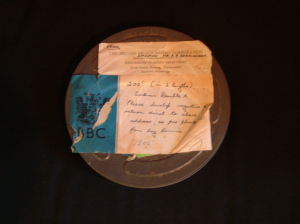
The film was duly developed and retuned to us in time for our programme – but of course it was negative. My connection with film was, however, still maintained, as I was running TK! Laced it all up, ran on cue, but unfortunately I did not really see much of the rest our course production.
Film as loaded into TK – two excerpts:
TK Insert into Studio:
In the club before the message arrives….
Dashing along the road to Wood Norton Hall …
Alec Bray
Training course at Wood Norton – on this day we were learning how to be good Gram Ops. Two turntables – Jimmy Shand and his band on both turntables. Jimmy Shand was reasonably popular at this time – “White Heather Club” type Scottish dance music The idea was to play the first disk, then start up the second, drop the needle at a suitable spot on the record and then cross fade between the two turntables with no audible discontinuity. Jimmy Shand and his band was used because the music was VERY difficult to identify a suitable mixing point (because it was so repetitious you could easily get it wrong|). After a while, we thought it would be fun to try to mix into a Light Programme feed (this was the main ring main feed). Just our luck that the Light Programme was playing the very same Jimmy Shand and his Band track …
—
It is to my lasting regret that I cleared out a lot of my BBC memorabilia before I came across the Tech Ops website – you could have had the complete TO 16 course notes!
I was clearing out more stuff and I came across some negatives taken during my training on TO 16. The negatives were taken on Kodak glass plates, 3.25 by 4.25 inches, panchro-royal P.1600 (yup, still in their box) – did we have to load up the plate camera in a darkroom?
Anyway the task was to light a couple of objects in an interesting way and then light a person – and the homework was to write a critique of the lighting setup.
Unfortunately, the negatives have not survived well in my loft, but one of them scanned on the HP scanner: the other (that has a lot of degradation) I put on a light box – er, rather, I blue-tacked it to the window and took a photo of it using 2+ and 4+ closeup filters on a handheld DSLR ( a Canon EOS 550 D): I know I should have used a tripod…
(Click on the pictures below to see them on their own:
use your Browser’s BACK button to return to this page)
There is another photo of me, but surely one is enough! There were other photos of the guy I was working with – and his interesting setup, but I have not got those negs, I wrote my critique of the photos, including the photos of the models (er, us): I went to town criticising the nose shadow that the pair of us had got on at least one of the portraits, only to have the write-up returned with the comment “Typical Television nose shadow”!
Our end-of-course exam – aside from the practical production exercise – was to approach a Marconi image orthicon camera which was sick, diagnose what was wrong with it and tweak the knobs on the camera and CCU until we got a recognisable picture. Just about managed it in time!
TO 18
Peter Cook
This photo was taken by one Roger Prior during one of the 2 TO18 end of course programme exercises. No prizes for guessing who the operator was, but look at the up-to-date equipment! Vinten sprung panning head, Mk 2? Note the floor standing LS and the dexion. Health and Safety would have a field day with all the junk. The camera I remember as a Pye Mk 3 (3″ IO). If I was looking bored that was because I was locked off on a caption. I was probably feeling smug because I had just passed my driving test first time. The Phoenix would have needed a bit of a clear up before the next badminton game.
TO 18
Geoff Hawkes
I joined in September 1963 and along with Jeff Booth was put on Crew 5, then under the leadership of Dickie Ashman, with Jim Atkinson as his number two, Paul Kay as Camera 3 and Rodney Taylor as Camera 4. As you know in those days we spent the first three months on a crew before going to Evesham and I thought this a good idea before getting down to the boring bits of study. I recall Lawrie Duley’s inspirational speech when we arrived, in which ended with, “And welcome to show business.” The tag “…but remember, you’re not here to enjoy yourselves” was added later, probably by the likes of Otis Eddie.
Of that initial three months, half was spent on Cameras and half on Sound. The SA1 on Sound Crew 5 was Kevin White. Other members of Sound Crew 5 were Gordon Rolls as SA2, with Mike Williams as SA3, to whom I was attached. I think there were two William’s in those days. The one I’m talking about left after a few years to pursue a career elsewhere. It was he who showed me that you could go into the Red or Blue crush bar and ask for a milky tea, or a milky coffee and would be served it in a green china cup with a metal teaspoon and not so much as a hint that “You’re a fussy one aren’t you?” I was impressed and thought, “Yes, the BBC is how the civilised world should be!.”
In April 1964, after Evesham (TO 18), I was sent to Sound crew 1, where Dave Hawthorne was SA1 and Mike Brown was SA3. I can’t remember who else was on sound, apart from a pre-Evesham Gerry Ellis and Denise Daveley as Gram-op, the only woman in Tech-ops. One of their shows was “Compact” and I had my first experience of going into the grid to rig mics, Neumann KM54’s or something like that, suspended over office doors. That in the days before pocket-less clothing was insisted upon. “Just don’t drop a screw driver on anyone’s head,” was what we were told, but not being an engineer(!), I didn’t carry one anyway. It was fun, if a bit nerve racking doing a boom on “Compact”, especially the live editions, but the Sound Supervisor, Frank Radcliffe was always very understanding and his sessions for notes in the SCR just before transmission were something I still remember. He had a very reassuring sort of voice and it was just like being part of a family.
Doug Coldwell
I was on TO 18 over new Year 1963/4 and before being shipped out to Hampton House (Redundant Stores) in the town was perplexed by the long queues for the “payphone” by the entrance to D Block.
Shortly after we were given a stiff lecture about naughty “goings on” and terminations. Most of usinnocents left the classroom wondering what that was all about.
My recollection of that particular payphone was that naughty ex GPO folk on an engineering course had somehow visited the exchange in the town. The police were involved and their course photo didn’t need many chairs.
TO 19 April – July 1964
Geoff Fletcher
Lots of room ragging – emptying Huw Thomas’ side of his shared room completely, even down to one curtain, and hiding all his kit with other victims of Huw’s pranks.
Eric’s (Sound TO) Heinkel bubble car placed in the ablutions at the end of D Block corridor via the double doors whose lock we picked.
Sabotaging the BBC2 “Hullabaloo and Custard” float in the river pageant so it slowly sank.
Shinning up a lamp post in front of the hall and painting a smiley face on it.
Illicit late night cocoa parties with the female Sound TOs in Dorm X.
Baiting Creeping Jesus and his dog in several imaginative ways.
Parking Bob Gillis’ MG Y Type in the hallowed 10 spaces, letting down its built-in jacks, and removing all four wheels.
Planting rude message in the front lawn – don’t know if that ever bore fruit.
Inserting rude subliminal messages into our programme exercise.
Illegal night “raves” up the hill by the pool.
Breaking into the PA system and reading out daft announcements all morning before anyone in “authority” noticed.
Weekend river races in hired boats resulting in complaints to Doc Sturley and Co. And much much more.
Photo shows Bill Marsh in D Block corridor rescuing his bed from the ablutions room.
Lots of us on TO19 settled down to watch the opening night of BBC2 – we couldn’t believe what we were (not) seeing! The general opinion was that we should go away and down several pints of ale to get over our disappointment.
Simon Fone was on TO 19. In the photo attached I’m on the left with Bob Foley, Simon centre frame – in the Phoenix – our Sound control area for our programme.

TO 19 production:
TO 19 Radio Tech Ops
Geoff Fletcher
Thanks to the kind efforts of Doug Caldwell and his friend and ex TO 19 member Jackie:
Course Photo. men left to right are:
Alan Stennet (late of Radio Lincoln), Bob Saunders, Mike Stace (a
senior SM at Broadcasting House until quite recently), ?,
Julian Walther, Mark ? (now in Canada), Brian Robinson or Robertson, ?,
Ian Samsom, Barry ?
ladies left to right are:
Anne Semple, Chris Van Embden, Chris Payne (Service Resource Manager
Europe, Studio Ops Bush House until April 1995, Jackie Spacey(Service Resource Manager Overseas, Studio Ops Bush House until April
1995), Pat Woodfield, Carole Staines.
TA 22
Mike Jordan
(TA 22 – sorry not Tech Ops but we were allowed to play with Radio studios in the evening!)
We also had the message about a new swimming pool on my TA course in 1966.
Also one has to remember the stories of the Mini in the D block washrooms (no private facilities in those days).
The guy who did himself a serious injury by riding on his motorbike down the stepped corridor in D block.
The group who decided to switch off the D Block power on the breakers half way down the aforementioned corridor – and, of course, blacked out the Sick Bay which was in one of the wings of the block.
The sheep in Harry Crossley’s bedroom.
Putting all the furniture on top of the wardrobes so on entering, it looked as if the room had been emptied.
The Major’s boat brought up from the river and put in the bear pit – sorry, swimming pool.
As Comms guys, we had access to the MCR (in the old kitchen in the main building by the main drive) and of course overplugged the Light Programme ring main feed (secret line from Daventry?) with Radio Caroline off the check receiver. Very popular and lecturers even came in to check the tuning.
Last but not least the “Le Mans” start up the drive on Friday evening to beat the traffic jam on the Workman Bridge in Evesham – no bypass then.
We won’t spread to boozy lunches at the Anchor in Fladbury, (cider about 9d a pint as opposed to about 6d at Emley Castle complete with apple cores floating) goings-on in Reg’s BBC Club in Evesham and so on and so on!
TO 23
Peter Neill
I was there (though not an active participant) for the Mini escapade. TO23 was a large course (about 100 students) split into Radio, TV and regions, with a good percentage of the lectures being shared across all three sections. The only females on the course numbered about three or four, in the radio section. One of them had a Mini. She acted as though she was a cut above the rest of us. The few of us males who did have cars had old bangers. Many of us had come straight from school and hadn’t earned anything yet but she was apparently of independent means. She needed taking down a peg or two. D block consisted of a long corridor with steps at intervals (cf motorcycle story) and a large communal washroom at the lower end. (And to think that they charged us rent!) There were a pair of large barn-type doors in the far wall. A hefty padlock secured them. But the hinges were unprotected and a couple of screwdrivers borrowed from the workshop made short work of them. There was no question of obtaining the car keys, so the Mini was carried bodily up from the car park, lifted through the doors and, if memory serves, turned through 90° so that it couldn’t just be driven out. The door hinges were then screwed back on. I can’t remember how she found out that her beloved car was now in the men’s bogs, but she wasn’t pleased.
TO 29
Graeme Wall
In my time there was a very pretty barmaid at the Emley Castle that many of us tried, and failed, to get off with. About a month after we left Evesham someone came into the gallery with a copy of Mayfair magazine, the barmaid was the centre spread that month!
TO 32
Brian Curtis
I well remember the “filming” of “Dr Who” “Spearhead From Space” in Oct-Nov 1969!
A number of us who were on TO 32 were able to view the “filming” both in the “medical section” (on of the larger dorm rooms in C Block I think?) I recall it took nine takes just to get one shot where two extras had to lift a blanket off Dr Who (Jon Pertwee) lying on a bed and in lifting it raise it as a “mechanical” wipe/blackout in front of the camera!
Also in the main TV studio where some sort of “alien being” (large scene construction) had been built!
I recall that one of the scene crew had a nasty moment when copious amounts of “dry ice” smoke was being used in the “alien being” (he was operating “tentacles”) and due to poor ventilation he was nearly overcome and had to burst his way out to breathe.
Some of us even became unofficial “runners” collecting bits of kit and fetching teas etc from the canteen.
David Brunt
It was Jon Pertwee’s first – strikebound – Doctor Who story “Spearhead From Space” that was done at Wood Norton in October-November 1969. Mostly interiors, but with some around the main building.Coincidentally, Tom Baker’s first “Robot” was also OBed among the exterior buildings on the site in April-May 1974.
Brian Curtis and Warwick Cross
Wood Norton was used as a prison camp in one of the Beeb’s George Smiley episodes – the final episode (7) of “Tinker, Taylor, Soldier, Spy” – as well as a series of (strike hit) “Dr.Who”s.
STO Course in April/May 1971
Tony Crake
I have found six old photographs from the “Programme Exercise” featuring [those] who were on the STO Course in April/May 1971.
Some 43 years later I struggle to remember all the people on the course… Barry Bonner and Chris Eames who I still bump into now and again but also Paul Graydon, Gerry Ellis, John Dailley, Doug Puddifoot, John Ford, Joe Driver and masses of others.
When everybody allocated themselves to being Cameramen, Director or Lighting Supervisor etc etc.. I was rather left standing there and somebody said “Oh Tony, you can be the Scriptwriter! ”
Well I sort of set to ( aided by Paul and Barry), and came up with this rolling “One Show” sort of thing which had a few running gags and isolated daft things like Me and John Dailley doing a Cookery Item!
The most adventurous bit was the “blowing up of the BBC bus”! We needed some “explosives” and if I remember correctly Mike Talbot Smith (the Senior Sound Lecturer) had a friend who worked for the Army and obtained a ‘thunderflash’ or two and a real smoke Bomb ! It was all deemed a great success! Sadly the tape was erased not long after its premiere ! It would have been interesting to see it now……
Here are six pictures:
(Click on picture to see larger version:
use browser BACK button to return to this page)
TA 28
Roger S
The construction of the bunker.
The bunker was a great disappointment when it was finally released for us to use it for training purposes when I was a lecturer back in the 1970s. Brought up on stories of 24/7 lorries carting the spoil away for months on end. Of them using the tallest tower crane in the UK and the jib would only just clear the ground, it was so deep..
Two other crazy things about the place. First, there was no means of locking the main door from the inside. So come Armageddon and the hordes roaming the countryside, there would be no way of keeping them out!
Second, they seemed to have connected up the airco the wrong way round as the inside was under negative pressure….so each time the front door was opened, any radioactive dust would have been sucked in!
Alex Thomas
I attended the STO course at Wood Norton in 1965.
The Warden, Major Basil Oldman, was probably the resident MI 5 rep on this BBC outpost and took the security of the Regional Seat of Government that had been built there very seriously.
These holes in the ground had to be filled with concrete on a continuous pouring so that there were no seams as the concrete set. A stream of concrete mixing lorries arrived over several weeks, day and night, discharging their loads and attracting interest from the local paper.
The Major was asked what all the concrete was for and told the journalist that it was for a new swimming pool for the students. That would have been that, but the paper then started a campaign to allow the residents of Evesham who had no swimming pool in the town to use this “pool”.
Major Oldman was also convinced that the Chinese restaurant in Evesham was a cover for a nest of spies and shared his worries with everybody.
STO 38
John Nottage, John Hays
On STO 38 John Hays went to a garden centre in Amersham and bought a bag of 100 crocus bulbs which we planted late at night on the grass slope by the exit road using wire frame guides in the shape of the course number. I’m told STO 39, the sneaky bums, dug a few up to change the 8 to a 9!
Exciting times!
Telephones
Mike Jordan
The good one from Wood Norton – and that got a stiff warning from Gippie-Joe – was that by dialling successive “local” codes (discovered while stopping off at various phone boxes between London and Evesham) one after the other, one could call London or wherever one lived for a local call charge.
However the only problem was that by the time one got through, it was a shouting match to be heard over the added together line losses! STD put an end to that of course.
Slightly similar but a bit OT was being very naughty in BH by dialling internally 67-68-67-68 etc etc and establishing a call going backwards and forwards between BH and TC.
Tony Scott
I’m told that when STD was first introduced it was possible to get free calls by using a tone generator to mimic the dialling tones, or in one case, by whistling!!
Many years ago Robin Luxford and Derek Saunders dialled all the 3 letter/ figure prefixes (eg 111) and reached the MI5 switchboard but were abruptly cut off when they didn’t know the password.
Robin convinced his wife that he could build a washing machine if he could buy a lathe and welding equipment. The result was a machine that went berserk in the kitchen.
Tony Crake
As Evesham was the first PO Experimental STD area it was somewhat unique. It was certainly discovered on my Induction Course (Sept 62). It had a big snag.. the rest of the country still had trunk operators. So once you had dialled out to Cheltenham (94 say) and back to Evesham (96 say) you came back in at ‘operator level’ ….Then YOU had to ask for which exchange you ACTUALLY required so you had to sound like an operator… sometimes successful sometimes not.. The Evesham operators were then replaced with direct access by dialling another code which could connect you to another regional exchange. Hours were spent on dialling endless numerical combinations to see which exchange answered! We (shared rooms then) had (for some weird reason) the PO junction box for the call box IN our old D block room! Coming back from the Club at closing time we would often find “diallers” in our room with telephone and tape machines replicating “money sounds” down the line!
Peter Cook
This account of dialling out and back in on operator level resonates with that of an wiz OB engineer (GM) who evidently was careful enough at the time to avoid detection. STD telephone system was introduced in the late 1950s, so by 1962 it would have been old hat to the bright sparks. Of course the other STD had been around a bit longer. I refer to the affliction Billy Connelly would refer to as “diseases of the Willy”. Can’t say I remember much evidence of that at Wood Norton, despite the weekly influx of teachers and nurses for the dances in the Evesham Club, or the odd well heeled mini driver.
Pat Heigham
I’m afraid it was a guy on my course (March ’62) who spent most of his evening, testing out the inter-exchange codes to get London calls at local rates!
Now another story…
One evening raising elbows at the Evesham club, somebody said – “There’s a film tonight” This was in one of the studios, off 16mm Bell & Howell. I drove a few chaps back, to be overtaken by Jim? (Think he was from regions – judging from his Scots accent) on his motorbike. He scorched past us on the long left hander bend – his footrest hit the tarmac, and he spun off in a shower of sparks into a cabbage/brussels sprouts field.
Pitch dark – we scrambled out and went calling:
“Jim, Jim!”
From the darkness; “I’m over herre, and I’m allrrigghttt!”
The film was ‘Dr. No” the first Bond. Little did I realise that later in my film career, I would be on the sound crew of two further ones in the series!
(For those that may be interested – I wrote an article written for the “Journal of the Association
of Motion Picture Sound” – See <Journal Bond at 50.pdf>)
A Wood Norton Hut in 2013
Mike Jordan
Wood Norton Hall June 2013


